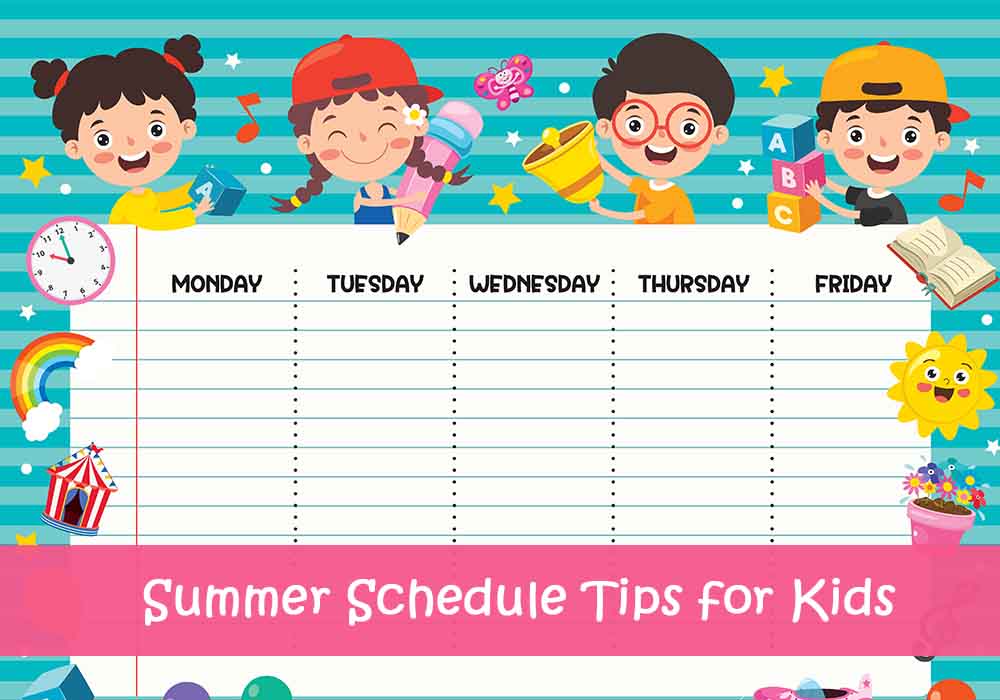As a mom, creating a summer schedule for your kids can be tasking, especially if you are a busy mom. In this article, we have developed a comprehensive guide to creating the Best Summer Schedule for your Kids.
We understand the importance of designing a well-structured and engaging summer routine that keeps children entertained, learning, and happy throughout their vacations.
In this post, we covered why having a summer schedule for your kids is important, summer schedule tips for your kids, and a summer schedule example you can adopt for your kids.
Let’s delve into this guide.
Importance of Summer Schedule for Kids
A well-structured summer schedule is of utmost importance for kids as it offers a wide array of benefits that contribute to their overall growth and development. Let’s delve into the significance of having a thoughtfully planned summer routine:
- Maintains Routine and Stability
- Fosters Continuous Learning
- Balances Entertainment and Productivity
- Develops Life Skills
- Enhances Physical and Mental Health
- Strengthens Family Bonds
- Reduces Screen Time Dependency
- Boosts Confidence and Independence
- Creates Lasting Memories
- Prepares for a Smooth Transition Back to School
A well-structured summer schedule for kids is essential as it ensures routine, continuous learning, and balanced entertainment.
By incorporating educational activities, it prevents the “summer slide” and maintains their academic progress.
Moreover, it fosters the development of life skills, enhances physical and mental health, and reduces screen time dependency.
The schedule also strengthens family bonds through quality time spent together and boosts children’s confidence and independence as they accomplish tasks and explore new activities.
Additionally, it prepares children for a smooth transition back to school, alleviating any anxieties associated with the new academic year.
Overall, a thoughtfully planned summer schedule not only provides a fulfilling and enjoyable vacation for kids but also contributes to their long-term growth, creating cherished memories along the way.

1. Engaging in Outdoor Activities
Summer is the perfect time for kids to embrace the great outdoors.
To create an outstanding summer schedule, ensure it includes various exciting outdoor activities. From nature walks and picnics in the park to fun-filled days at the beach, outdoor activities provide numerous benefits for children’s physical and mental development.
Not only will they have a blast, but they’ll also soak up vitamin D and experience the wonders of nature.
Nature Scavenger Hunt: Create a list of items for your kids to find in nature, such as specific leaves, rocks, or flowers. This activity encourages observation skills and a deeper appreciation for the environment.
Backyard Camping: Set up a mini-campsite in your backyard. Let your kids experience the thrill of camping under the stars, complete with a bonfire and marshmallow roasting.
Outdoor Sports Day: Plan a day filled with various sports like soccer, basketball, frisbee, and relay races. It promotes teamwork, healthy competition, and physical fitness.
Gardening Fun: Start a small garden together. Allow your kids to plant seeds, water the plants, and watch them grow. This activity teaches responsibility and patience.
Beach Olympics: If you’re near a beach, organize a beach Olympics with sandcastle-building competitions, beach volleyball, and beach relay races. It’s a fantastic way to bond as a family while enjoying the sun and sea.
Check Out Outdoor Activities for Toddlers
2. Enriching Educational Programs
Let’s not forget the significance of education during the summer break. We recommend integrating enriching educational programs into your kids’ schedule.
These programs can be tailored to their interests and age group.
Whether it’s attending a science camp, joining a book club, or taking up a new hobby like painting or coding, these activities will keep their minds sharp and foster a love for learning.
Science Experiments at Home: Conduct simple science experiments using household items. Show them the fun side of science with volcano eruptions, making slime, or growing crystals.
Virtual Museum Tours: Many museums offer virtual tours. Take advantage of this opportunity to explore famous museums worldwide from the comfort of your home.
Book Reading Challenge: Set a summer reading challenge where your kids have to read a certain number of books. Create a rewards system to motivate them and celebrate their achievements.
Explore Historical Sites: Visit historical landmarks or monuments in your area. Teach them about the history and significance of these places, making learning engaging and immersive.
STEM Kits and DIY Projects: Purchase STEM (Science, Technology, Engineering, Math) kits or opt for DIY projects that allow your kids to build and create while learning important concepts.
3. Creative Indoor Playtime
While outdoor adventures are essential, indoor playtime is equally crucial, especially during scorching summer days.
Organize creative and stimulating indoor activities that encourage imaginative play. From building forts and playing board games to engaging in arts and crafts projects, these activities not only entertain but also nurture their creativity and problem-solving skills.
Indoor Treasure Hunt: Set up a treasure hunt with clues hidden around the house, leading to a small prize. It keeps the excitement alive and encourages problem-solving.
Puppet Show: Encourage your kids to put on a puppet show using old socks, felt, or paper bags. Let their imagination run wild as they create characters and storylines.
Indoor Obstacle Course: Design a safe and fun obstacle course using pillows, chairs, and hula hoops. It’s a great way to keep them active and entertained indoors.
DIY Science Experiments: Conduct safe and exciting science experiments in the kitchen, such as making homemade volcanoes, slime, or invisible ink.
Artistic Collage: Provide old magazines, scissors, and glue for them to create artistic collages. It’s a wonderful outlet for their creativity and self-expression.
4. Sports and Physical Fitness
Physical fitness is essential for children’s growth and well-being. Incorporate various sports and physical activities into your summer schedule.
Consider swimming, soccer, cycling, or even yoga sessions. Apart from being enjoyable, these activities promote teamwork, discipline, and overall health.
Family Bike Rides: Plan family bike rides in the neighborhood or local parks. Cycling is a low-impact exercise that improves cardiovascular health and builds stamina.
Hiking Adventures: Explore nearby hiking trails as a family. Hiking offers an excellent opportunity to connect with nature and provides a great workout for the entire body.
Water Balloon Fight: Beat the heat with a fun water balloon fight. It’s an enjoyable way to stay active and cool during hot summer days.
Dance Parties: Turn on some energetic music and have dance parties at home. Dancing is a fantastic full-body workout that also uplifts moods and reduces stress.
Yoga for Kids: Introduce your kids to yoga with child-friendly poses. Yoga enhances flexibility, balance, and mindfulness, promoting a sense of calm and focus.
5. Science and Nature Exploration
Promote curiosity and a love for science and nature by planning exploration days. Visit local museums, science centers, botanical gardens, or zoos.
These excursions offer a great blend of fun and education, allowing children to explore the world around them and learn fascinating facts about animals, plants, and the universe.
Animal Tracking: Go on nature walks to spot animal tracks and identify the creatures living in your area. It’s a thrilling way to learn about local wildlife.
Stargazing Nights: Stay up late for stargazing sessions. Use astronomy apps to identify constellations and teach them about the wonders of the universe.
Plant a Butterfly Garden: Grow plants that attract butterflies and observe the life cycle of these beautiful insects up close.
Cloud Watching: Spend a relaxing afternoon cloud watching and identifying different cloud shapes. It encourages imagination and observation skills.
Bug Hunt: Equip your kids with magnifying glasses and bug-catching kits to explore the world of insects and arachnids in your backyard or a nearby park.
6. Cooking Adventures
Cooking is an educational and fun activity that kids adore. Plan cooking adventures in your summer schedule, allowing your little chefs to whip up their favorite treats.
From baking cookies to creating colorful fruit salads, cooking fosters essential skills like following instructions, measurements, and patience.
Bake-a-Thon: Dedicate a day to baking various treats with your kids. From cookies and cupcakes to homemade bread, the joy of baking together is unmatched.
Make Your Own Pizza Night: Set up a pizza-making station with different toppings and let your kids create their own personalized pizzas. It’s a delicious and interactive experience.
Smoothie Creations: Teach your kids the art of making healthy and tasty smoothies using fresh fruits, yogurt, and a splash of creativity.
International Cuisine: Explore different cultures through their cuisine. Choose a country each week and cook a traditional dish together, broadening their culinary horizons.
Family Cook-Off: Organize a friendly cook-off competition where each family member prepares a dish. Not only does it encourage healthy competition, but it also strengthens family bonds.
7. Music and Art
Artistic expression is vital for children’s emotional development. Incorporate music and art activities into their daily routine.
Arrange music lessons or encourage them to explore different musical instruments.
Host drawing sessions, painting workshops, or pottery classes to nurture their creativity and self-expression.
Musical Instruments Showcase: If your kids are learning to play musical instruments, let them put on a small concert for the family to showcase their progress and talent.
Art in Nature: Venture outdoors to paint or draw landscapes and natural scenes. Encourage them to use watercolors or sketch pencils to capture the beauty around them.
DIY Musical Instruments: Help your kids create their musical instruments using recycled materials. From rain sticks to cardboard guitars, this activity combines creativity and music.
Family Karaoke Night: Host a karaoke night at home, allowing everyone to pick their favorite songs and sing their hearts out.
Art Appreciation: Visit art galleries or explore famous artworks online. Discuss the various styles and artists, inspiring a deeper appreciation for the world of art.
8. Interactive Storytelling and Reading
Reading is a fantastic way to expand your child’s imagination and improve their language skills. Schedule regular storytelling sessions where you read aloud to them, or encourage them to participate in interactive storytelling activities.
Create a cozy reading nook with a selection of age-appropriate books to inspire a lifelong love for reading.
Act Out Stories: Choose a favorite storybook and take turns acting out the characters and narrating the tale. It brings stories to life and encourages public speaking skills.
Create Story Cubes: Make story cubes with different images on each side. Roll the cubes to generate random story elements, igniting their imagination for endless storytelling.
Story Chain: Begin a story with a few sentences and have each family member add a sentence to continue the narrative. Witness the creativity flow as the story unfolds.
Book Reviews: After reading a book, encourage your kids to write short book reviews. It improves their writing skills and helps others discover great reads.
Storytime Podcasts: Explore storytelling podcasts for kids. They can listen to captivating tales while relaxing or during road trips.
9. Community Service Projects
Instill empathy and kindness in your children by engaging them in community service projects. Volunteer at local shelters, clean up the neighborhood, or organize a charity event.
These activities will teach them the value of giving back and being responsible citizens.
Clean-Up Drive: Organize a neighborhood clean-up drive where families work together to make the community cleaner and greener.
Visit Senior Centers: Spend time at local senior centers, engaging in activities with the elderly residents and brightening their day.
Care Packages: Create care packages with essential items and deliver them to homeless shelters or those in need.
Plant a Tree: Initiate a tree-planting campaign to contribute positively to the environment and teach kids about the importance of conservation.
Thank You Notes: Encourage your kids to write thank-you notes to essential workers, expressing gratitude for their efforts.
10. Flexible Rest and Free Play
Lastly, ensure your summer schedule allows for flexible rest and free playtime.
Structure is essential, but so is spontaneity. Kids need downtime to recharge and engage in unstructured play.
Balance structured activities with free time, where they can choose their own games and activities.
Unplugged Time: Schedule periods of unplugged time, allowing your kids to disconnect from screens and engage in imaginative free play.
Quiet Reading Hour: Designate a specific hour each day for quiet reading, promoting a love for books and quiet contemplation.
Free Art Time: Provide art supplies and let your kids create freely without any instructions or guidelines.
Pretend Play: Set up a pretend play area with costumes and props, allowing them to immerse themselves in imaginative worlds.
Nature Playdate: Arrange playdates with friends in natural settings like parks, encouraging social interaction and outdoor exploration.
Summer Schedule for Kids Example
| Time | Activity |
|---|---|
| 8:00 AM | Breakfast and Getting Ready |
| 9:00 AM | Outdoor Playtime (Nature Walk/Park) |
| 10:30 AM | Snack Break |
| 11:00 AM | Educational Program (Science Camp) |
| 12:30 PM | Lunch Time |
| 1:30 PM | Creative Indoor Play (Arts & Crafts) |
| 2:30 PM | Sports and Physical Fitness |
| 3:30 PM | Afternoon Snack and Rest |
| 4:00 PM | Music and Art (Drawing/Piano Lesson) |
| 5:00 PM | Reading and Interactive Storytelling |
| 6:00 PM | Family Dinner |
| 7:00 PM | Evening Community Service Project |
| 8:00 PM | Free Play and Screen Time |
| 9:00 PM | Wind-Down Activities (Reading/Board Games) |
| 9:30 PM | Bedtime Routine |
Items Needed In Summer Schedule for Kids
In a summer schedule for kids, you will need a variety of items to ensure a well-rounded and enjoyable experience. Here are some essential items to include:
- Outdoor Toys and Equipment
- Art Supplies
- Educational Materials
- Sports Gear
- Cooking Supplies
- Musical Instruments
- Outdoor Gear
- Educational Program Materials
- Books and Storytelling Materials
- Community Service Supplies
- Screen Time Management Tools
- Comfortable Clothing
Remember to tailor the items based on your child’s interests and age group, and be prepared to adjust the schedule and materials as needed throughout the summer for an enjoyable and enriching experience.
Wrapping Up
By incorporating these engaging and enriching activities, your kids are sure to have a summer full of joy, learning, and unforgettable experiences.
Remember, balance is key, so ensure your schedule strikes a harmonious blend of structured activities and free play.
Embrace the summer with open arms, and let this season become a cherished memory for your kids and a valuable asset for your website.



